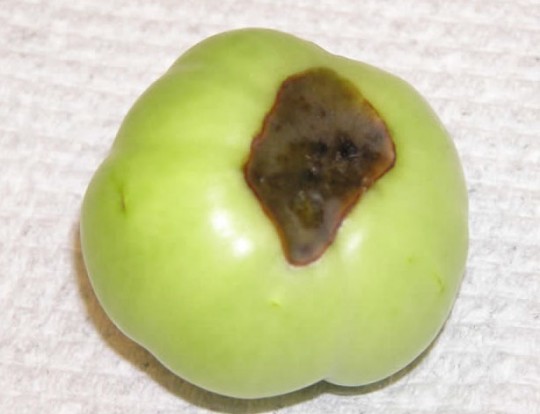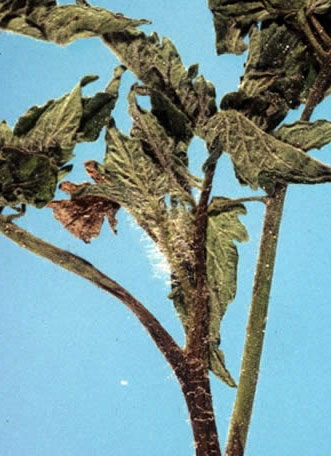Learn How To Troubleshoot Tomato Problems
June 20, 2010
 There’s a reason why farmers and avid gardeners watch the weather so closely. Climatic conditions such as temperature, rainfall and humidity can greatly influence which disorders are likely to affect a crop.
There’s a reason why farmers and avid gardeners watch the weather so closely. Climatic conditions such as temperature, rainfall and humidity can greatly influence which disorders are likely to affect a crop.
Currently, conditions exist that are ideal for several tomato disorders. If you are growing tomato plants, be on the lookout for blossom-end rot and late blight.
A dark water-soaked area on the blossom end of the tomato may indicate a calcium deficiency
The uptake of calcium from the soil by the plant can be reduced by fluctuations in soil moisture – either excessively wet soil or excessively dry soil. Fluctuations in soil moisture may cause blossom-end rot.
 Prevent blossom-end rot by maintaining a soil pH around 6.5 and uniform soil moisture by irrigating and mulching, and avoid heavy applications of nitrogen.
Prevent blossom-end rot by maintaining a soil pH around 6.5 and uniform soil moisture by irrigating and mulching, and avoid heavy applications of nitrogen.
If you do experience blossom-end rot, spray the plant’s foliage with 2 level tablespoons of 96 percent calcium chloride in 1 gallon of water at seven to 10-day intervals. Several convenient “stop-rot” products are available at local garden centers. Begin spraying with the first appearance of symptoms. Overdosing plants with calcium chloride may result in leaf burn. Spray on cloudy days or wait until the sun is low.
Blossom-end rot
Blossom-end rot is a common problem on tomatoes but can also occur on peppers, squash, and watermelons. It is more common on fruit that is one-third to one-half grown, and it occurs on the blossom end of the fruit. It is not a disease but a calcium deficiency.
As the tomato develops, water moves rapidly into the developing fruit. However, calcium moves slowly in plants and even slower into the fruit. Calcium is an important component in plant cells and a lack of calcium will result in small, water-soaked spots that develop into dark brown, leathery spots that may involve half the fruit.
Late blight
 Late blight is a disease caused by a fungus. It is best known as the disease that was responsible for the Irish potato famine in the mid-nineteenth century. It affects many plants in the Solanaceae family, including tomato, potato, pepper, and eggplant.
Late blight is a disease caused by a fungus. It is best known as the disease that was responsible for the Irish potato famine in the mid-nineteenth century. It affects many plants in the Solanaceae family, including tomato, potato, pepper, and eggplant.
Since the pathogen does not survive in the soil, it usually enters the garden on infected transplants or live spores that are blown in with wind or rain. It spreads most rapidly during moderate temperatures (60° to 80°F) and high moisture conditions such as rain, fog, heavy dews or high relative humidity.
Recent climatic conditions have caused an outbreak of late blight in southeast Louisiana.
On tomato leaves, the symptoms of late blight initially consist of light brown to purplish spots that rapidly enlarge to purplish, blighted areas. Early in the morning and under wet conditions, a white growth of the fungus may be visible on the lower leaf surface. Stems may become infected, as well, with large purple to black sections that make stems look as if they were burned.
Several preventative and control measures are required.
- Scouting: regularly inspect your tomato plants and try to catch this disease as soon as possible to prevent its spread.
- Sanitation: eliminate infected plants as soon as the disease is identified.
- Applying fungicides: spray plants on a regular basis with fungicides such as chlorothalonil, mancozeb, copper or a combination of mancozeb plus copper. When using the mixture of mancozeb and copper, allow it to sit for about 30 minutes before spraying and stir it frequently. Chlorothalonil may be used up to and including the day of harvest, whereas mancozeb cannot be used within five days of harvest. Because these fungicides are protectants only, thorough spray coverage is essential for control.
With any luck, warmer weather will slow this disease but gardeners should keep an eye on their prized tomato plants.
For more information, contact Theresa Friday at 850-623-3868 or email tlfriday@ufl.edu. Friday is the Residential Horticulture Extension Agent for Santa Rosa County.
Courtesy photos for NorthEscambia.com, click to enlarge.
Comments
10 Responses to “Learn How To Troubleshoot Tomato Problems”



How do we stop pests from biting the tomatoes ,something is eating
my tomatoes when they turn red and some of the green ones too . It has been said thjat due to the very hot and rainless summer we have had that rodents are biting and leaving the bitten tomatoe on the branch . i have tried everything I could think of to get rid of them. Nothing works I guess the last resort is to put out poison. I don’t know what is doing this.
Pathfinder:
Click for info…
i too am getting side rotting on green ‘maters that vary from close to ripening to very small nickel sized fruit.this is the first thing i’ve been able to find on garden sites.please someone hurry.have had a lot of rain and not much sun–other than that,no other problems worth mentioning
William, I wonder if you could get Ms. Friday to do another article to answer our questions here? Mine about the side rotting and the one about white splotchy hard spots. I have that problem too.
We gave up on tomatoes because of the wild life getting them first. I would like to be able to give up on privet, please tell us what Pathfinder is.
What can I do to stop those bad white and hard spoty blotches that completely ruin a tomatoe I feel certain it is some sort of deficiency but need a botonist’s point of view and expertice.
I hate privit too but Pathfinder will render it helpless.
Stink bugs……how do you get rid of them…????
wow… this is awesome info! I lost a LOT of tomatoes to this and experimented with lots of stuff until I evidently got it right.
We plant Tomatos, we get wild berries and weeds.
We plant Peppers, we get more Privet.
Privet,privet and more privet. Everywhere you look, I’m cutting down privet.
Oh,by the way….we have never once planted any privet.
I don’t have blossom end rot because I amended my soil with calcium before planting, but my tomatoes are rotting on the sides just as they start to ripen. Does anyone know what causes this and what I can do?